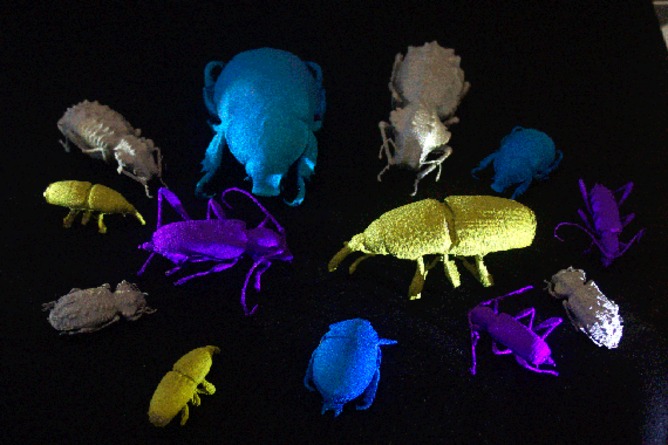The InsectScan 3D uses standard components and costs less than $8000 to create digital 3D models - and we can print them in 3D, too.
3D scanned images, printed in 3D. Image by Eleanor Gates-Stuart
How many insect specimens do you think are in the Australian National Insect Collection? A few hundred thousand? A million?
Actually, at the moment, it has about 12 million specimens, and it’s growing by about 100,000 a year. Like many natural history collections around the globe, the ANIC holds thousands of holotypes – each the single specimen of a species that is used to define its characteristic features.
There are all sorts of uses for these specimens, and a lot of people outside the world of entomology have very good reasons for looking at them very closely. But they’re fragile things, and many of them are tiny, so they can’t really leave their cases. And photographs don’t capture all the detail that’s sometimes needed.
So how to make the necessary information available to the people who can use it, while keeping the precious specimens safe and available for research work? Digital 3D colour modelling is ideal, but there have been some major barriers to doing that effectively. The system most used at present – Micro Computed Tomography (Micro CT) can create amazingly accurate models. But it doesn’t capture the object’s natural colour, which is vital information for species identification. It can take many hours. It’s X-ray based, so it needs special safety equipment. The machines also cost around $100,000, and they’re not portable.
Well, there had to be a better way, didn’t there?
So Matt Adcock and his colleagues did some lateral thinking, and came up with InsectScan 3D. This re-imagines 3D image-gathering in a way that doesn’t need custom-made or high-cost equipment (some of it actually came from the local hardware megastore), and the image is in full colour. The entire system uses standard components, and costs less than $8000 for the hardware and software. The digital 3D models come out in a file size small enough to be sent by email and used in web pages. And to make it even better, we can 3D print them.
The process uses multiple photographs of the subject, mounted on a disc marked with a pattern of dots. Using a standard DSLR camera and a 2-axis turntable, the insect is photographed at different angles and focus depths. These are then plotted by a computer, using the dot pattern to gauge the angle from which the picture was taken.
In some cases the 3D image is more useful than conventional microscopy. Obviously, the actual specimen provides all the information, but it has to be examined under a microscope for features like the mouth area and hair surface on the head. Out-of-focus effect and other physical restrictions makes using a microscope to view the actual specimen more difficult than viewing the 3D model.
The possibilities for this system are varied. Entomologists and taxonomists already have a massive backlog of insect types which have not yet been digitised in any form, and this system can provide what they’ve been asking for: a network of automated instruments that can clear the backlog by quickly and accurately creating 3D images of type specimens.
Schools and universities can use 3D models of insects as rich education materials, so students can interact with insects without endangering the fragile specimens.
But the most interesting use could be in quarantine and biosecurity. Invasive insects and the diseases they carry are an ever-present threat to Australia‘s environment, its agricultural industries and the health of the population. With this affordable, portable and accurate scanning technology, quarantine officers could carry a 3D gallery of invasive insects with them on inspections to help identify pests. Suspect specimens could be scanned in 3D and sent straight to an expert entomologist for examination. High resolution image libraries will mean we can quickly extract, analyse and share rich information, supporting biodiversity discovery, species identification, quarantine control, and unlocking the value of our biological collections.
Sounds pretty good, doesn’t it? This technology is a finalist in the Smart 100 innovation awards, and there’s a people’s choice category. If you like it as much as we do, we’d really like you to vote for it. All you need to do is click the ‘Share on Facebook’ (or Twitter, or any of the others) button and that’s a vote.


